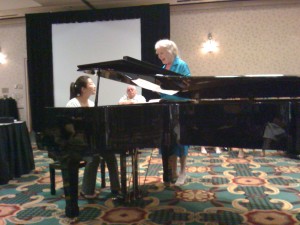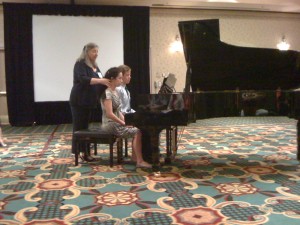Masterclasses Galore
Wow! Four masterclasses over the course of two days- what a conference! Masterclasses provide more learning opportunities than any other lesson format, I think. The student receives the benefit of another point of view about the piece and their playing, teachers observe and improve their diagnostic and teaching skills, and fellow students discover new repertoire and set new goals for their playing. Win win!
 Liszt is speaking through you to them- said Pianist Barbara Nissman to a l6 year old student. She taught five students, ages 6 to 26, during two masterclasses. Throughout the classes her focus was on the musical intent of each composer.
Liszt is speaking through you to them- said Pianist Barbara Nissman to a l6 year old student. She taught five students, ages 6 to 26, during two masterclasses. Throughout the classes her focus was on the musical intent of each composer.
She guided each student through small details of dynamic contrast, articulation, phrase shape, and pedaling and, in demanding excellence, helped them attain a higher level of artistry. In nearly every case she ended by telling the student to go home, work through the piece in detail and apply the concepts they had worked on together.
Ms. Nissman demonstrated all that she asked of the students in her own solo recital. The music was elegantly phrased with no agogics or deforming of the lines- just pianistic plain speaking (of course when you have that command of the keyboard, there is no need to use these particular tools).
That’s not to say that the music was plain. Liszt, Barber, Prokofieff, and Rachmaninoff were all in 3D. Even in the most complicated, technically onerous passages each voice in the texture had purpose and an individual timbre. For me the Prokofieff Sixth Sonata was unquestionably the high point of the evening. (here’s a link to an interview with Ms. Nissman from The Prokofiev Page)
Pamela Blanc, a teacher of the Alexander Technique, conducted two masterclasses and a session at the conference. She worked with all the teachers in a group and individually with pianists, singers, and a young string quartet. Her focus was on freeing performers of tension so that each could say and do whatever they desired as an artist.
She began each lesson by asking each performer how they felt and what they were thinking during their performance. She tailored every  lesson to the answers she heard, addressing physical complaints and any off topic thoughts which interfered with the performances. Allow your body to participate– she stressed.
lesson to the answers she heard, addressing physical complaints and any off topic thoughts which interfered with the performances. Allow your body to participate– she stressed.
In every case, after freeing the head on top of the spine, and adjusting other elements of breathing and posture, and acknowledging any off topic thoughts, the performances changed dramatically for the better, becoming freer, and more vibrantly alive.
As I sit here writing this post, I am thinking out the top of my head, down to my feet, and breathing out through my breathing container.
I had two favorite comments. The first was from an 11 year old violinist- I thought it sounded cleaner and overall …yeah. The second was from a teacher who told us how no one ever taught him how to manage tension- It’s so much better not feel like you are the victim of the instrument.
Many thanks to masterclass coordinators, Kassandra Weleck and Sara Stapley, who did a wonderful job arranging for a diverse group of performers and repertoire.



great article – gail!